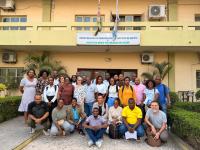World Health Organization warns gap greater than 50% in the treatment of epilepsy in the Americas and the Caribbean
 "People who have epilepsy and do not receive treatment suffer from recurrent episodes. This may affect their studies, work, and quality of life, in addition to their families", said Claudina Cayetano, a Pan American Health Organization regional advisor on mental health. The disease is one of the most common neurological disorders, affecting approximately 50 million people worldwide. Of these, five million are from the Americas and the Caribbean. It is estimated that more than half of these patients do not receive treatment. For this reason, Opas published the document "The Management of Epilepsy in the Public Health Sector 2018" . The Organization, which is also the regional office of the World Health Organization (WHO), believes that epilepsy is a priority public health problem.
"People who have epilepsy and do not receive treatment suffer from recurrent episodes. This may affect their studies, work, and quality of life, in addition to their families", said Claudina Cayetano, a Pan American Health Organization regional advisor on mental health. The disease is one of the most common neurological disorders, affecting approximately 50 million people worldwide. Of these, five million are from the Americas and the Caribbean. It is estimated that more than half of these patients do not receive treatment. For this reason, Opas published the document "The Management of Epilepsy in the Public Health Sector 2018" . The Organization, which is also the regional office of the World Health Organization (WHO), believes that epilepsy is a priority public health problem.
Despite the worrying data, two out of three countries in the region do not have a program to meet those affected by the disorder. Attention to chronic noncommunicable diseases has gained momentum in recent years. As of 2011, the PAHO Governing Council has adopted a strategy to improve the response of the health sector. Four years later, the World Health Assembly also recognized the burden of epilepsy and the need for countries to take coordinated action to deal with its consequences. However, the results have not yet been satisfactory.
Access to medicines
It is believed that the reasons why actions in the Americas and the Caribbean have not been effective are, among other factors: the lack of trained professionals, the lack of incentive to educate about epilepsy, both for patients and for the general population, and the unavailability of medicines - especially in primary health care (PHC).
According to the Opas, most of these countries have the four essential remedies for the treatment of epilepsy, however only in specialized services. That is, access to medicines is limited, whereas, in fact, it should be broad in PHC. The WHO recommends integration of disease management, since it considers the diagnosis to be essentially clinical and can be performed by non-specialist physicians. The episodes of the disorder can be controlled by treatment with only one of the basic drugs (monotherapy). To promote access to affordable anti-epileptics and reduce this large treatment gap, PAHO relies on the Strategic Fund, a mechanism for cooperation with countries.
The guide
In addition to these points, the guide also offers strategies for preventing epilepsy, such as promoting pregnancy and safe birth, preventing brain injury and stroke, as well as raising awareness and the public.
The new publication, in addition to the recent efforts of this decade, was submitted to the consultation of a group of professionals from the International League Against Epilepsy (ILAE) and the International Bureau for Epilepsy (IBE), as well as specialists from the Chilean League against Epilepsy and the Faculty of Medicine of the National Autonomous University of Honduras, both collaborating centers of PAHO / WHO.
About Epilepsy
Epilepsy is characterized by recurrent seizures, which can last from a few seconds to a few minutes. The disease affects people of any age group for various reasons. In some cases, there is a genetic link, but other causes include brain damage caused by prenatal or perinatal injuries; congenital anomalies or brain malformations; cranioencephalic trauma; cerebrovascular accidents; infections such as meningitis, encephalitis and neurocysticercosis; and brain tumors.
Among disorder is responsible for 0.5% of the global burden of diseases. Two million new cases of the disease occur every year in the world, but in developing countries this record is twice as high as that of developed countries. Regarding mortality, in Latin America and the Caribbean the rate is 1.04 per 100,000 inhabitants, higher than 0.50 per 100,000 inhabitants in the United States and Canada.
Treatment
70% of affected people can be treated with basic medicines and only 10% of cases require a specialized approach with diet or surgery. Regarding effectiveness, about 20% of complex cases do not respond. It is estimated, however, that if treatment coverage with antiepileptic drugs is extended to 50% of cases, the current overall burden of the disease would be reduced by between 13% and 40%.
80% of countries in the Americas and Caribbean region do not have adequate legislation on the disease. "With a timely diagnosis, appropriate treatment, healthy diet and stress management, up to 70% of those affected by the disease can reduce the crisis and lead a full and active life," said Claudina Cayetano.



